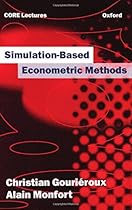Simulation-Based Econometric Methods (OUP/CORE Lecture Series)

| Author | : | |
| Rating | : | 4.54 (753 Votes) |
| Asin | : | 0198774753 |
| Format Type | : | paperback |
| Number of Pages | : | 192 Pages |
| Publish Date | : | 2013-12-26 |
| Language | : | English |
DESCRIPTION:
`A thorough study.' ASLIB Book Guide`'The remaining chapters are devoted to applications.These are very useful since they give a precise idea of what has to be done in order to implement, from a practical point of view, the theoretical methods discussedThis book provides a very good review of the available methods that are proposed in recent econometric literature, along with a critical discussion'' Economic Notes 3
Christian Gourieroux is at ENSAE and the University of Paris IX. Alain Monfort is at ENSAE and the Ecole Polytechnique, Paris.
The general principle of indirect inference is presented and is then applied to limited dependent variable models and to financial series.. The previous difficulties presented by the presence of integrals of large dimensions in the probability density functions or in the moments can be circumvented by a simulation-based approach. After linear models leading to analytical expressions for estimators, and non-linear models using numerical optimization algorithms, the availability of high- speed computing has enabled econometricians to consider econometric models without simple analytical expressions. This book introduces a new generation of statistical econometrics. They then move to calibration problems and the simulated analogue of the method of moments, before considering simulated versions of maximum likelihood, pseudo-maximum likelihood, or non-linear least squares. After a brief survey of classical parametric and semi-parametric non-linear estimation methods and a description of problems in which criterion functions contain integrals, the authors present a general form of the model where it is possible to simulate the observations
Wonderful Introduction to the Topic A truly wonderful book. If you like simulation-based methods or you are just interested in learning about the frontier in econometrics, buy this book. You are not going to find a better introduction or a clearer description of issues. Daniel Ventosa S said A very disappointing book: extremely complicated. Christian Gouriéroux is maybe the best French econometrician. In particular, his last discovery, the indirect inference, seems to be a very clever way of solving the problem of highly complicated likelihood functions. But in this book, only A very disappointing book: extremely complicated Daniel Ventosa S Christian Gouriéroux is maybe the best French econometrician. In particular, his last discovery, the indirect inference, seems to be a very clever way of solving the problem of highly complicated likelihood functions. But in this book, only 4 pages are dedicated to present the subject, and they are filled with over complicated mathematical formula. pages are dedicated to present the subject, and they are filled with over complicated mathematical formula. Notations I don't feel so much difficulty with this book but the notation I've just finished Ch.1 and the beginning of Ch.2 but I found several parts which need improvement on notations. He uses unfamiliar symbol(a version of pi?) for very complicated statement for explanation of LDV model. In GMM part, he first uses K as a function and in the next sentence he use
